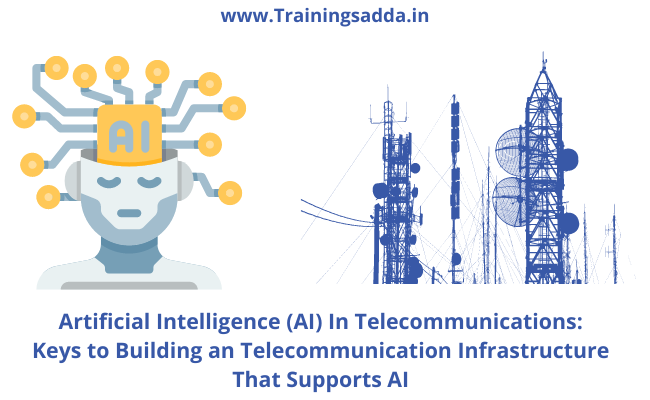AI In Telecommunications: Keys to Building an Infrastructure

Last Updated on June 28, 2023 by admin
The ongoing integration of artificial intelligence (AI) and telecommunications has brought about a dynamic transformation in how communication and connectivity take place. With AI-backed telecommunications infrastructures, businesses around the globe can now avail of previously unavailable opportunities to enhance customer service offerings, leverage detailed analytics, and combat fraudulent activities effectively.
The result is a highly optimized system that has revolutionized the way businesses interact with their clients. But to truly tap into the potential of AI within the telecommunications sphere, organizations must embrace a modernized telecom framework that seamlessly integrates artificial intelligence.
In order to effectively address the obstacles and possibilities presented by this sophisticated technology, it is crucial to understand them comprehensively and develop strategic approaches to efficiently address potential challenges arising from integration.
Table of Contents
The Role of Artificial Intelligence in the Telecommunications Industry
In recent years, Artificial Intelligence (AI) has become a major catalyst for change in the telecommunications industry. It has brought about a variety of innovative technologies that are transforming how companies function.
Know more: What are the differences between Artificial Intelligence and Machine Learning?
From cutting-edge self-managing networks to highly intelligent customer service tools, AI is rapidly transforming the rules of the game for this sector.
Autonomous Network Administration
The future of telecommunications network management lies in intelligent automation. With the exponential growth of data traffic, it has become imperative for network administrators to integrate AI-driven solutions to efficiently oversee and manage the network.
AI’s capability to analyze enormous quantities of data enables it to detect and diagnose network problems in real time, resulting in more efficient and effective network monitoring and reporting. In turn, this leads to a self-optimizing network that can quickly address issues, ultimately enhancing customer satisfaction.
AI-Driven Customer Assistance
Nowadays, customers expect 24-hour support services. AI-powered chatbots and virtual assistants have become the solution for telecommunications companies to provide this support. They offer customers an easy-to-use platform to connect with the service provider, provide immediate answers and assistance to their queries, and deliver relevant recommendations.
As a result, customer service reps can now focus on more complex issues instead of menial tasks. Companies like Virgin Mobile have already recorded a surge in customer satisfaction ratings after introducing AI-based chatbots as the primary point of contact.
Optimized Network Functionality
One of the most significant advantages of AI-based network management is optimized network functionality. AI algorithms can analyze network data to predict traffic demand, identify bottlenecks, and provide better resource allocation.
This insight enables companies to tweak their network operations to reduce costs, improve connectivity, and offer customers an overall better user experience. Optimally functioning networks’ impact is faster data speeds, fewer dropped calls, and minimized network downtime.
Obstacles in AI Infrastructure Development
Much like any other technological advancement, AI-driven telecom solutions come with their own set of challenges. Below are some of the biggest obstacles in AI infrastructure development in the telco industry.
1. Data Management
One of the most significant obstacles in AI infrastructure development is data management, including data quality, privacy, and accessibility. Data is the bread and butter of AI, and using relevant and clean data is necessary to develop accurate AI models. However, this requires significant investment in data management tools, infrastructure, and trained personnel.
Data privacy has emerged as a critical concern in the development of AI infrastructure. Companies must adhere to regulations and safeguard customer data, which can lead to bottlenecks and hinder growth. To combat these challenges, organizations must prioritize data management and invest in tools and strategies that ensure the quality, privacy, and accessibility of data.
2. Infrastructure scalability
Another significant obstacle is infrastructure scalability, particularly for organizations just starting with AI. As data sets grow and models become more complex, organizations must scale up infrastructure to accommodate these changes. However, traditional infrastructure and on-premise resources may not be sufficient to handle large-scale AI deployment.
Addressing this obstacle can be accomplished by implementing cloud computing services, which offer a highly flexible and scalable infrastructure. Highly-regarded providers such as Amazon Web Services, Azure, and Google Cloud Platform furnish on-demand resources, streamlining rapidly scaling infrastructure to fulfill operational demands.
3. Skill Shortage
The development of AI infrastructure necessitates specific expertise, and there is an escalating demand for such professionals.
Unfortunately, the current pool of AI-trained experts falls short of the number required to handle the intricacies of establishing an efficient AI infrastructure. This dearth of skills can result in bottlenecks during AI development initiatives, ultimately leading to inferior quality models and project delays.
Organizations need to invest in AI training programs, re-skilling, and up-skilling current employees to address this obstacle. Organizations should also encourage and support STEM education to prepare the next generation of AI professionals.
4. Explainability and Accountability
AI models are highly complex, and explaining how they generate their predictions or decisions can be challenging. This lack of transparency can lead to mistrust and accountability concerns. Therefore, organizations must prioritize explainability and develop ways to audit AI models, ensure accuracy, and minimize bias.
Organizations should implement explainable AI frameworks to overcome this obstacle that provide insights into the model’s decision-making process. For example, explainable AI tools such as LIME, Shapley, and Anchor can help develop accurate and interpretable models.
5. Legacy Systems
Many organizations have legacy systems incompatible with modern AI tools and infrastructure. Overcoming these barriers means investing in upgrading these legacy systems to support AI capabilities fully.
Organizations can adopt a phased approach to AI implementation to address this challenge, starting with small-scale pilots on a subset of data. This approach can help organizations identify areas that require process re-engineering or system upgrades to become AI-ready.
Also know: Artificial Emotional Intelligence: Yet another Replacement of Humans
AI Modeling Techniques
Organizations must also consider the modeling techniques used when it comes to AI infrastructure development. There are several AI algorithms and approaches. Below are some of the most popular ones:
Predictive Analytics
Predictive Analytics enables the Telco industry to leverage the vast amounts of data it generates to predict customer behavior, technical failures, and potential service downtime before they occur. For example, indicating when customers will churn helps companies create personalized offers to retain them.
Network Optimization
Artificial Intelligence-powered network optimization is another critical area of AI modeling techniques being applied in Telco. For instance, Machine Learning (ML) algorithms enable Telco businesses to analyze vast amounts of data collected from network components such as routers, switches, and network devices to optimize performance, bandwidth allocation, and network reliability.
Intelligent Customer Service
Customer service is a critical component of the Telco business. AI-based Machine Learning algorithms enable it to automate routine customer service tasks and provide intelligent customer service by predicting customer needs based on usage patterns, contact history, demographics, and location.
Fraud Detection
Telecom fraud is a significant problem that siphons billions of dollars annually. Therefore, ML algorithms detect anomalies in data to stop fraudulent activity in real-time. In addition, the algorithms use historical data to identify patterns of fraudulent behavior and signal possible fraudulent activities to agents.
Smart Advertising
AI-based advertising effectively allows Telco businesses to maximize their advertising dollar. It enables companies to leverage customer data to effectively create personalized advertisements that resonate with audiences.
With real-time optimization, smart advertising assists businesses in making informed decisions about their advertising campaigns by analyzing performance data and adjusting target demographics as necessary.
Start Benefiting From AI in Telecommunications
AI is a powerful tool that can be used to optimize various aspects of the telecommunications industry. By leveraging predictive analytics, network optimization, intelligent customer service, fraud detection, and smart advertising techniques with AI modeling tools, telecom businesses can increase efficiency while reducing costs and improving overall customer satisfaction.
Author Bio:
Subbu Seetharaman is the Director Of Engineering, at Lantronix, a global provider of turnkey solutions and engineering services for the Internet of Things (IoT). Subbu is an engineering executive with over 25 years of experience in leading software development teams, building geographically distributed, high-performing teams involved in developing complex software products around programmable hardware devices.
Comments
0 comments




